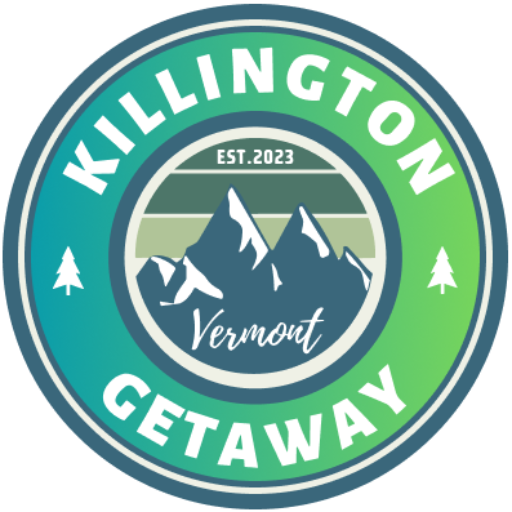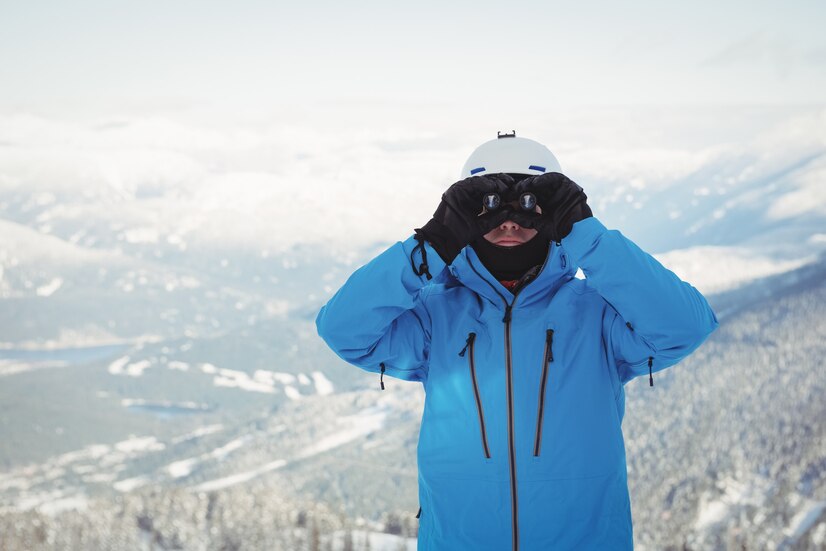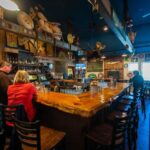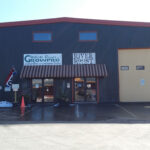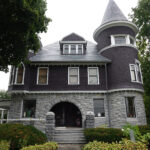Go from beginner to speaking like a total ski nerd with our introduction to the vocabulary of skiing: definitions and explanations so you can take a quick knack of it!
APRÈS SKI
/apres ski:/
(noun)
Time for socializing after a fun day on the slopes
TREE WELL
/tri wel/
(noun)
The area around the base of a tree, creating a hollow that you can fall into after heavy snow.
GNAR
/’na:/
(adjective)
Shortened from Gnarly. Generally used by those who shred it or in a mocking fashion. Meaning high on the ‘danger and cool’ scale
A big list of skiing terms and phrases
Skiing and snowboarding, are the fundamental joys of the slopes! Ascend the peak, buckle up those skis or board, and carve your way down the mountain. It’s pure, it’s alpine, and it’s exhilarating. However, venture deeper into the ski universe, and you’ll encounter a whole new lexicon of ski lingo, slang, and jargon that might leave you a bit baffled. Fear not! We’ve compiled an extensive list of terms and phrases to get you shredding through the slopes with fluency in the language of skiing. Get ready to learn the complete glossary of ski and snowboard terms.
Tip: You can click or tap on one of the blue letters below to go to the section you want to browse.
A B C D E F G H I J K L M N O P Q R S T U V W X Y Z
A
Air – The act of jumping with skis or snowboards on. The higher you leave the ground the bigger the air you have.
Alpine skiing – This is probably what you are in the mountains for, skiing downhill with the toe and heel of your boot fixed to the ski.
Après ski – At the end of your ski day it’s time for a few drinks. Directly after skiing, often still in your boots and slope-side, think dancing on tables with wild European music blaring loudly or some live music and plenty of beer. Take a look at the best places for Aprè ski in Killington.
Avalanche – When a slope becomes unstable and the snow cascades down it, often building in momentum and dragging everything in its path along for the ride. They are incredibly dangerous.
B
Backcountry – Skiing for those who shun the pistes. There are no lifts to the backcountry, you’re going to be walking outside the ski area boundary where there is no avalanche control and skiing is much riskier. Though you may get untouched powder skiing, it’s best to take a guide and make sure you have all the necessary equipment. (Backcountry.com is also a great site for discount gear)
Bail – A term used when you fall over, often spectacularly.
Balaclava – Worn on your face, or rather over it. It covers all skin whilst still allowing you to see. Perfect in freezing temperatures or driving snow.
Black run – The steepest of runs, often so steep they get icy. It is generally full of people trying to prove themselves rather than actually enjoying skiing. But if this is your bag then these are the runs for you.
Blue run – a pisted slope for progressing onto, nice and mellow, can be a lot of fun.
Bombing – Flying down the ski slopes at breakneck speed.
Bowl – A large basin-type area of the mountain, often un-pisted and high up. Generally, you can ski down any part of it so you can pick your own route for large swooping turns or daredevil speed chutes.
Bunny hill – North American term for a beginner slope.
Buttering/butter – Playing around on snowboard or skis without jumping. Essentially smearing your skis/board across the snow in a fashion not dissimilar to buttering toast. Bending your board off the ground and/or spinning around without leaving the ground.
Button lift – A lift that doesn’t lift you off the ground, you stick a pole with a little button seat on it between your legs and it drags you (on your skis) up the mountain. Particularly annoying for snowboarders.
C
Camber – The opposite of rocker (see further down this list) tips and tails of board/ski touch the ground when the middle does not. This helps with grip and stability on the piste and at a speed.
Carving – The process of digging in the edge of your skis or snowboard to create a smooth turn.
Cat track – A route used by the piste bashers (or cats) to get around the mountain can often be almost completely flat but creates a convenient link between two places on the mountain.
Catch an edge – On a snowboard, when the edge of your board accidentally catches on the snow which pulls you abruptly towards that edge and in general fall flat on the floor.
Champagne powder – The lightest, fluffiest snow you can imagine. Officially trademarked by Steamboat Resort, meaning technically champagne powder cannot be found anywhere else.
Corduroy – (Or grooming) freshly made piste. This is machine-packed by the snow cats into a ribbed or plowed texture that resembles a corduroy pattern.
Chute – A steep narrow slope often with high sides and off-piste.
Couloir – Like a chute, incredibly narrow with high rock faces on either side.
Cross-country skiing – Originally used as a form of transportation across the snow, it is skiing on flat ground using momentum powered by yourself by ‘skating’ or ‘striding’. The skis and boots are much lighter and narrower than alpine skiing.
Crust – You get this mainly in the mornings when the top layer of snow has frozen solid (the crust) so you break through it to the soft snow underneath.
D
DIN setting – How firmly the skis are attached to your feet (in simple terms) this has to be set correctly according to your weight, shoe size, and ability in order for the ski to release if you crash/don’t fall off whilst you’re skiing. It’s universal so will be the same wherever you ski, but best left for the pros to set it.
Doorstep skiing – This term has a little wiggle room depending on who’s using it but essentially means where you are staying is very close to the slopes but not quite ski in, ski out. This may be because you have to cross a road or the hotel is at the bottom of the slopes etc.
Dump – A slang term for bucket loads of snow. Often in a short space of time making wonderful powder skiing conditions.
E
Edge – The edge of your skis or snowboarding, used in carving and generally skiing/snowboarding.
F
Faceplant – falling straight onto your face – self-explanatory really.
Fall Line – The quickest route down the mountain, the route a ball or avalanche would take if you rolled it down the mountain.
First tracks – Getting up before the rest of the resort to catch the first lift up the mountain in order to be the first people down the mountain making the first tracks on the freshly groomed piste. Some resorts make an activity of it such as breakfast up the mountain and then you get half an hour before the main lifts open.
Flat light – when there is little to no contrast in the lighting, you have no shadows or gradients so everything invariably looks whitish and it can be hard to make out the lumps and bumps in the piste.
Freerider – One who prefers to ski/board off-piste, be that steep chutes, massive powder fields, or tight trees. Most likely to overhear bragging about their most amazing day ever.
French fries – Largely used when first learning to ski parallel. Basically having your skis next to (parallel) to each other like French fries lined up.
G
Glades – a term used when skiing through the trees, this is typically an area where the trees open up to create beautifully easy tree skiing.
Gnar – Shortened from Gnarly. Generally used by those who shred it or in a mocking fashion. Meaning high on the ‘danger and cool’ scale.
Green run – pistes for beginner skiers, very mellow sometimes almost flat. It is good to learn in a safe environment. See the Meet the Mountains Tour, specially designed for tourists and newbies.
H
Halfpipe – shaped like a gutter, it’s a U-shaped pipe carved out of the snow for freestyle skiers to perform all manner of awesome tricks on.
Hard pack – Very firm snow, could be icy. Often after a long time without fresh snowfall.
Hit – Anything you can jump off essentially or catch air. Could be in the terrain parks, off the side of the slope (side-hit), or off-piste.
I
In-bounds – when you are inside the marked ski area, this is where the mountains are controlled and deemed safe.
J
Japan-uary – A nickname given to the month of January in Japan due to the fact that the country gets unbelievable amounts of snow. It snows almost every day.
Jerry – A person who sets out to do something quite spectacular which is vastly above their ability or skill set.
Jib/jibbing – riding and sliding across non-snow surfaces such as rails, boxes, and anything not snowy basically.
Jump turn – A change of direction made by jumping with your skis. Generally used on very steep terrain when you don’t want to gather downhill momentum.
K
Kicker – a ski jump, generally in a wedge shape.
L
Line – the route you pick to ski down the mountain, where you make your turns, go fast, slow down… this is your line.
Liftie – a person who operates a ski lift.
M
Magic carpet – a conveyor belt area that typically transports you up a mellow/beginner piste. You stand on these with your skis still on.
Moguls – bumps that are either carved or naturally formed by skiers and boarders turning around them. Often occur towards the end of the ski day.
N
Nordic skiing – See cross-country skiing, another name used for this.
O
On-piste – a piste is a groomed slope or run, it’s a French word that is used more than any other ski term so worth learning. On-piste just means you are on the groomed slopes.
Off-piste – when you go off a marked piste into un-groomed snow.
P
Park – A terrain park on the snow full of jumps, rails, halfpipes, etc.
Park rat – Someone who spends every waking hour in the park hitting the jumps and rails.
Piste – See on-piste above.
Piste basher – Machines used to groom the pistes into perfect slopes. Sort of like a big tractor specially designed for steep slopes. Can also be called a cat.
Planker (two planker) – any skier.
Pomma lift – see button lift.
Powderhound – a skier or snowboarder completely obsessed with finding fresh powder stashes and riding in knee-deep powder.
Pow Pow – Fresh snow, most commonly found off-piste or after a fresh snowfall.
Pizza slice – officially called snowplow, a technique used when first learning to ski where your skis tilt together in the shape of a pizza slice. A way of controlling speed before learning to turn.
Q
Quad – four-person chairlift.
Quiver – One for you if you own your own pair of skis/board. Your quiver is the selection of skis/boards you have. So could be park skis, all mountain, freestyle, or a selection of various sizes for example. Or you could just have a quiver of one all-round ski/board.
R
Rail – A metal bar or box to slide across on your skis or snowboard. Mostly found in the terrain parks.
Red run – A pisted run that is steeper than a blue but won’t frighten the life out of you from the top. Great for holding a good speed and exploring the mountains.
Rocker – a cut of ski/board where if laid flat the middle section of a ski/board will touch the floor and the tip and tail will rise off it. It helps with float in snow and means you will be less likely to catch an edge but at the expense of high-speed stability and grip on pistes.
Rollers – An undulating slope where the peaks are rolling and you can often catch some air as you ski over them at a speed.
S
Side country – un-pisted area just off the side of a piste.
Ski in, ski out – When you can ski directly back to your accommodation and then ski from the door again in the mornings.
Skijoring – Like water skiing in the sense that you are pulled along over flat ground, but over snow, and the boat is replaced by a horse (or sometimes dogs).
Slopeside – next to the slopes/piste.
Snowplough – see ‘pizza slice’ above.
Steazy – Someone who makes being stylish look easy.
Straight lining – putting your skis parallel or pointing your board straight down the hill and really going hell for leather. A way for borders to make it over flat spots up ahead.
T
Tail – the back end of a ski or snowboard.
Touring (ski touring) – When both uphill and downhill travel is possible without removing your skis. ‘Skins’ are attached to the ski underside to give you grip traveling uphill and they are removed for downhill skiing. Typically this is for off-piste/backcountry skiing.
Tracked-out – When fresh snow has been skied over so much there’s no fresh snow left.
Transfer – How you get from the airport to the ski resort. You could have a private transfer just for you or a shared transfer with other people. You could also have a helicopter transfer if you really want to.
Traverse – Skiing/boarding across a slope or mountain rather than down it.
Twin tip – Where the back of your skis is curved up as well as the front allowing easier backward skiing and landing tricks.
Tree well – The area around the base of a tree, creating a hollow that you can fall into after heavy snow. They are incredibly hard to get back out of. These are super dangerous and can cause suffocation. So, to avoid them, always turn below a tree rather than above one.
Tree skiing – Skiing through the trees.
Twat gap – when the top of your goggles do not meet the rim of your helmet leaving a large exposed gap.
W
Whiteout – when visibility on the mountain drops to almost nothing, you may not be able to see your feet. This could be caused by heavy snowfall, fog, or both.
Wipe out – A particularly un-graceful or dramatic fall, you can also be wiped out by another skier or boarder – a crash.
